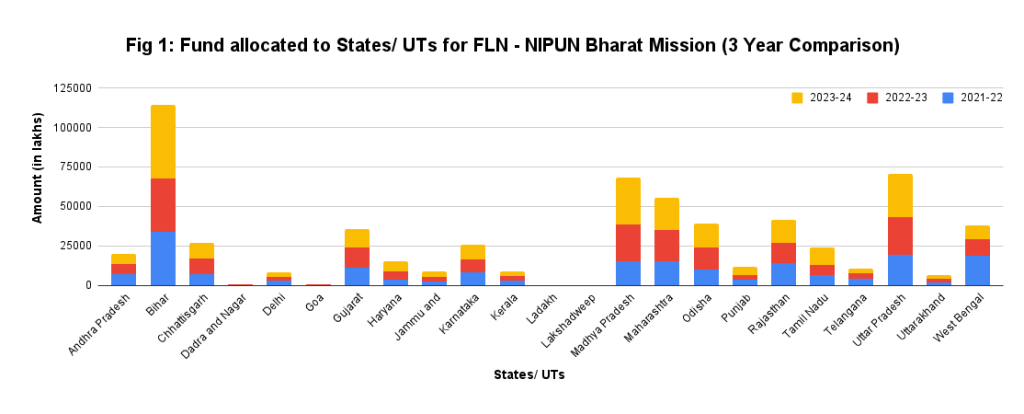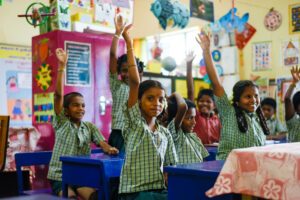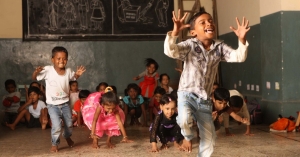What is the FLN Mission in India?
The National Education Policy 2020 placed the highest priority on Foundational Literacy and Numeracy (FLN). Para 2.2 of the Policy states, “The rest of this Policy will become relevant for our students only if this most basic learning requirement (i.e., reading, writing, and arithmetic at the foundational level) is first achieved”. To this end, a national mission on FLN called ‘National Initiative for Proficiency in Reading with Understanding and Numeracy (NIPUN) Bharat’ was launched in 2021 by the Ministry of Education (MoE) for students in the age group of 3-8 years. Accordingly, all state/union territory (UT) governments prepared an implementation plan for attaining universal foundational literacy and numeracy in all primary schools which involved identifying stage-wise targets & goals and closely tracking and monitoring the progress of the same.
Funding for the FLN Mission
Education is placed in List III i.e., Concurrent List of the Schedule VII of the Constitution of India, thereby making it fall under the joint domain of Union and states/UTs. States and UTs are provided funds for NIPUN Bharat Mission by the Government of India (GoI) through Samagra Shiksha (SS), an overarching programme for the school education sector extending from pre-school to class 12. Before the end of every financial year, the Project Approval Board (PAB) meeting is held under the chairmanship of Secretary, Department of School Education and Literacy (DoSE&L). In PAB meetings, each state, UT and autonomous body presents its Annual Work Plans and Budget (AWP&B), highlighting the initiatives and programme of activities along with proposed budget for the following fiscal year. Each component is discussed and as per the norms set under SS, funds are granted. As NIPUN Bharat Mission is one of the recent initiatives of GoI, DoSE&L communicated to states and UTs in 2020 for the inclusion of FLN in AWP&B for the first time. The Implementation Guidelines of NIPUN Bharat Mission also mention the framework for financial allocations for specific components of the mission. All this is integrated with the Samagra Shiksha: Framework for Implementation, released in 2022.
Financial Allocation Made to the States for FLN – Three-year Analysis
Since the inclusion of NIPUN in the PAB of Samagra Shiksha in 2021-22, more than six thousand crores have already been allocated for states in the past three years to meet the expenditure for the implementation of the mission. The provisions for financial allocations as per the NIPUN Implementation Guidelines along with a detailed account of allocations made for NIPUN in the PAB of the year 2022-23 and its analysis is given in this article.
The financial provisions of the Mission and SS Guidelines mandate the allocation of funds in proportion to the number of students, teachers, districts, etc. in the state/UT. Consequently, we witness that the largest financial allocations are being received by states with the most populous education ecosystem, such as Bihar – INR 1142 crores, Uttar Pradesh – INR 707 crores and Madhya Pradesh – INR 682 crores. Smaller UTs, such as Lakshadweep and Ladakh, proportionate to their number of students got lesser funds allocated, INR 122.56 lakh and 297.93 lakh respectively. The overall comparison of funds allocated to states is given in the figure below.

Potential Areas of Change in Financial Allocation for NIPUN Bharat Mission
As mentioned in the G20 New Delhi Leaders’ Declaration, foundational learning is the primary building block for education and employment that can have a long-term impact on the future of our country. Based on the analysis of the financial allocations made in the last three years, the following key areas can be prioritised while preparing the AWP&B for the next financial year:
- Separate allocation of funds for Information, Education and Communication (IEC)
Even though IEC for FLN is covered under ‘TLM for implementation of Innovative Pedagogies’, throughout the years, states have included separate funds for IEC for FLN mission in some form. In 2022-23, 3.29 crores were allocated only for ‘Display of Lakshyas and Targets’ as a separate category. In 2023-24, 1.54 crores were allocated in addition to the funds for FLN, solely for IEC related programmes to create awareness of FLN. These activities resulted in the participation of 5.25 crore people and created awareness with varied stakeholders on FLN and NIPUN. If we compare the amount being allocated for IEC in NIPUN to other pertinent government programmes then, an annual budget outlay ranging from 5-15% of the total mission budget was reserved for IEC activities in Swachh Bharat Mission. As FLN reform requires behavioural change with respect to the importance of foundational education, the government should allocate separate and larger funds for IEC activities.
- Allocation of funds for school readiness programme
‘Vidya Pravesh – a three-month play-based School Preparation Module for Grade-I’, has been developed by NCERT as per the recommendations of NEP 2020. All states and UTs have adopted it and it is being implemented across India. School readiness refers to whether a child is ready to make an easy and successful transition into school. It encompasses physical, social and academic domains necessary for a child to adjust to a school environment and keep pace with the primary school curriculum (Kagan, Moore, and Bredekamp, 1993). Despite the importance of this programme, only one state i.e., Gujarat has allocated funds towards the same in the past three years, even though there is a provision for the same in the SS norms. A programme evaluation study of its effectiveness is currently underway by MoE and NCERT but if more states allocate funds towards the programme, it is expected to provide better outcomes in the transition period of students in Grade 1. In light of this, MoE could look at nudging more states to allocate funds specifically for school readiness programmes.
- Additional funds for tech-enabled monitoring and assessment
NIPUN Implementation Guidelines lay special emphasis on monitoring the progress of the Mission through IT based solutions which shall include field-level, child-wise monitoring. The data set for the same should ideally come from large scale assessments and school-based assessments. So far, the majority of the fund allocation under assessments has been for large scale assessments (NAS, FLS). While there is continued effort at every level for these large scale assessments, some states, such as Uttar Pradesh, have gone a step further and developed an app (NIPUN Lakshya App) to assist teachers in their classroom teaching and assessment. One of the key features of the app is the option for teachers to conduct weekly assessments of students and record data in the app itself. Not only does it help keep a long-term record of the progress made by each student but also provides visibility to senior officials which helps in introducing appropriate initiatives.
Similarly, Telangana has developed an integrated monitoring system in the form of a Master App to track and review data across inputs, outputs, and outcomes with the goal of achieving learning outcomes for all primary-grade students (class 1-5) in the state with an evidence-based and data-driven approach. While initiatives such as these are being taken in some states, many are yet to formalise tech-based monitoring and assessment. Additional funding specific to progress monitoring will nudge all the states to develop their frameworks which will help regularly track the progress made, even at the school and child level.
- Funds for innovation/ innovative pedagogy
Though the broad category ‘TLM for implementation of Innovative pedagogies’ has been the highest recipient of funding throughout the years, upon closer analysis of the description of allocation, most funds are granted for the creation and distribution of conventional TLM. Though it is very much present in the name, unfortunately very little attention is given to ‘innovation or innovative pedagogy’ while allocating funds for FLN. States/ UTs, particularly SCERTs, should identify innovative practices as per the needs of their states and include them in their ABW&Ps. This level of personalisation with regard to innovative practices will help states and UTs better implement the FLN Mission. For instance, in Arunachal Pradesh under Arun Kiran programme, supplementary and contextualised reading material for FLN students was prepared by inviting Resource Persons from the districts and CBOs of different major tribes, who are well versed in their local language & folktales of their own tribe. On similar grounds, states can also contextualise Jadui Pitara, a play-based learning-teaching material tailored for children between the age group of 3-8 years and launched in 13 languages, to the mother tongue of their students for effective implementation.
The need for states to incorporate innovative practices in their ABW&Ps was also stressed on by senior officials of DoSE&L, MoE at the Regional Conference on FLN in Delhi on 26th – 27th September 2023.
NEP 2020 called for a National Mission for FLN more than three years ago. In these past three years, a lot has already been accomplished yet we are still far from achieving the target of the mission. As the mission is in advanced stages of its implementation, changes must be made, including the areas of fund allocation for India to achieve its FLN targets in a timely manner.
Note: All the data of financial allocation is collated from the publicly available PAB minutes document uploaded on DoSE&L website – here.



